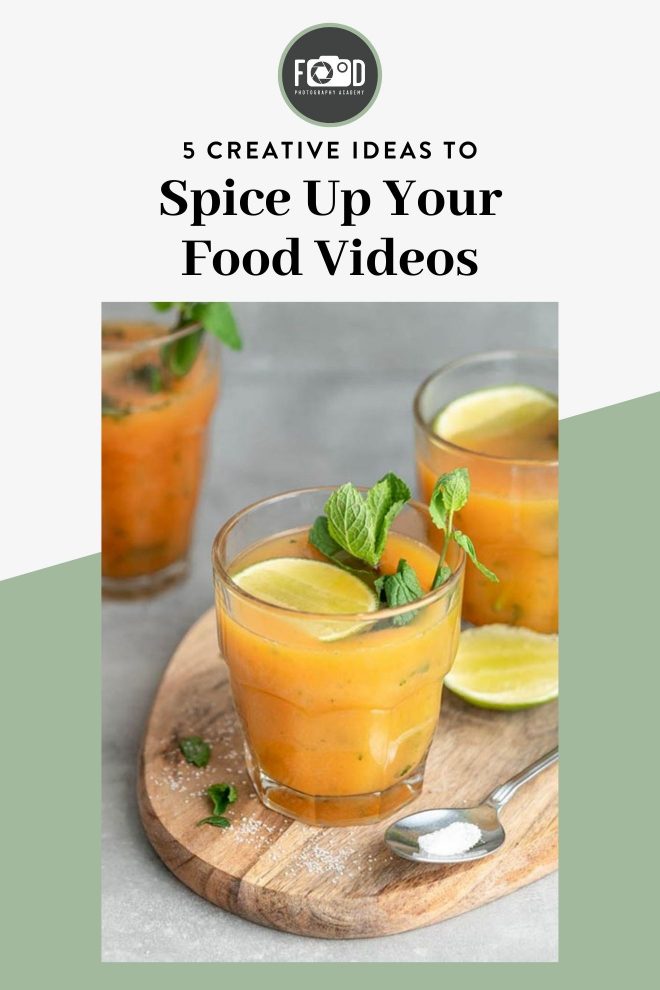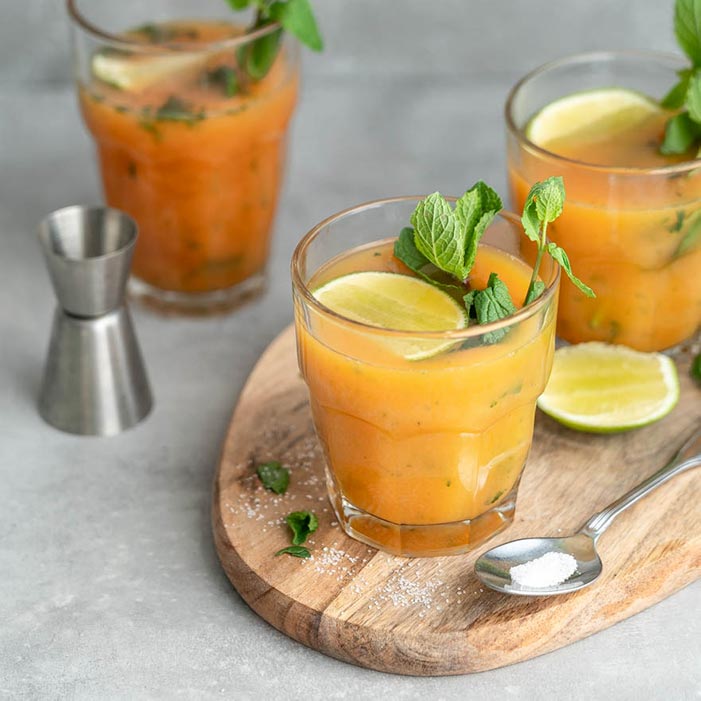Food tends not to move much. At least my food doesn’t: it’s all vegan. But that doesn’t mean that food videos have to be static and boring. In fact the number one advantage of video over, say, food photography is precisely its ability to tell a story through the combination of image, sound, and motion. So if you’re not paying close attention to all these elements in your food videos, you’re not making the best use of the video medium.

With today’s attention spans apparently shorter than ever, it’s essential to keep viewers hooked with dynamic and exciting footage – even when the subject itself can’t be relied upon to deliver an action-packed performance.
So if your food videos are just a series of fixed shots strung together with music in the editing room, it’s perhaps time you upped your directing game. In this post we look at some simple tricks for injecting a little more life into your food videos.
Circle Your Subject
Whenever possible you should look for ways to add action and movement to a scene. For example, rather than just showing ingredients lain out flat, let’s see them being rinsed, chopped, or poured into a dish: either way we understand what the ingredients are, but in the second scenario there’s a lot more going on to hold the viewer’s interest.
Realistically though, in any video there will likely have to be a few shots that contain little or no movement at all. At the very least you’ll probably want to end with a good long clip of the finished dish in all it’s glory.
But what’s the point of shooting video if it just ends up looking like you’re scrolling through a PowerPoint presentation? Even a totally static subject can be made more lively and interesting by a little creative camera movement. In this case by using the “orbit” technique.
In video-speak, orbiting is when you pan around a subject while keeping it in the centre of the frame. So although the subject itself may just be sitting there stock-still, slowly circling a dish as you shoot will help to give the clip a greater feeling of movement and excitement.
Follow the Action
But what about when the subject is moving? Is it enough just to let the action pass through a fixed frame?
Sometimes, yes. Others, no.
Closely following the action will always make for a much more dynamic clip than just sitting back and allowing the action to pass in front of a passive camera. And a series of dynamic clips of this kind edited together in quick succession can make for pretty exciting viewing.
For example, with our mandarin mojito recipe, instead of going for a mid-length shot that shows the pouring of rum and mandarin juice into the glass from a fixed point of view, we can opt for a much closer shot that follows the action in one fluid take. For example, a close-up of hands as they grab the bottle, remove the cap, and then pour the rum down into the glass – with the camera tightly tracking each step of the way like a chain reaction.
Related: 7 Tips To Create Magazine Worthy Drink Photography
In cases where the movement is subtler, or repeated on the same spot, try mimicking the action itself in your camera movements. Imagine you find yourself shooting a chef stirring ingredients in a mixing bowl. Rather than just plonking the camera on a tripod and leaving it there, you might instead move in sync with the chef’s hand on the spoon as it circles around the bowl. This way the viewer gains a much better impression of what it’s like to actually be there with the chef.
For this technique to work, you really need excellent freehand tracking skills, so that the movement is flawlessly fluid. It can also be beneficial to imagine that the camera is attached to your subject by an invisible stick, so that you maintain a constant distance from camera to subject as it moves. Not only will this help in more accurately mimicking the subject’s movement, but it’s pretty much essential in order to keep the subject in focus the whole time.
Go With the Flow
Movement is great, but it needs to remain consistent if it is to work once edited. This means planning your shots – and particularly the transitions between them – very carefully even before you start shooting.
In the section above we imagined a clip that follows the action as a bottle is opened and its contents poured into a glass. Let’s assume that the movement here took place from left to right: the bottle comes into frame on the left, the cap is removed, and the rum pours down into the glass on the lower right. The camera goes with it.
Now what?
Well, obviously the next clip in the sequence could be virtually anything you want. But what’s important is that any movement in the following clip maintains the same direction of travel as its predecessor: in this case, from upper left to lower right. I.e. unless we’re deliberately going for a disconcerting right/left/right/left effect, a clip that moves from left to right is not going to work in a sequence if it’s placed next to a clip that instead travels from right to left.
When carefully planned and executed, though, cutting from one moving clip into another can produce a very edgy and exciting sequence. Beyond respecting the direction of movement, the key here is coming up with clever transitions between each clip, leading to sequences that almost appear to be one single fluid shot, rather than several edited together.
Sure, you’re shooting a food video, not the latest installment of Jason Bourne’s improbable adventures. But using walls, objects and even people to “wipe” between two moving clips will add a further level of interest and professionalism to your videos. And if you really want to crank up the action, throw in a short snatch of random “whip pan” to shake things up between two clips.
Don’t want to be tied to editing exactly as you storyboarded? Shoot two versions of every moving clip, one in each direction, and you’ll be covered for every eventuality in the editing room.
Work the Angles
Holding the viewer’s interest isn’t just about rapid edits and constant motion though. It can be something as straightforward as just framing the shot in an unexpected way.
The reality of shooting food videos is that in many cases the viewer will have seen the subject – or at least something similar to it – before. We all know what a pizza looks like, for example. The challenge then is to show the subject in a fresh and surprising manner. Setting up your shots from unusual angles is an important part of this.
Think of a close-up of someone grinding pepper, for example, and you’ll likely imagine it shot front-on, from roughly the same height as the hand and grinder. But what if you instead shot the action from the point of view of the dish that’s being seasoned? A sheet of transparent Plexiglas is an indispensable bit of food video kit, allowing you to shoot dramatic clips of messy foods being thrown or poured down onto the camera from above.
As with any of the tricks we look at here though, shots from extreme angles need to be used in moderation, and only when they really make sense within the narrative: too many gratuitous shots from below or from other unfamiliar angles and you’ll risk disorienting the viewer.
Related: The 3 Best Camera Angles For Your Food Photography
Don’t forget the sounds
We most readily associate the experience of eating with taste, closely followed by smell, and lastly visual appearance. But the essential role that sound can make in stimulating appetite shouldn’t be overlooked when shooting food videos. Food is all about the senses, and although we may not always be conscious of it, sound is one of the most important senses we have.
Have fun with your sound design. Don’t leave it as an afterthought, but consider the kinds of sounds you may want to include in the final edit even as you begin to script your video. Who knows, you may even find that a certain sound ends up suggesting a new scene.
Of course, mint is hardly known for its powerful singing voice, nor mandarin oranges for their raucous behaviour. But in an example such as our mojito recipe, the appropriate use of chopping and squeezing sounds, or the clink and fizz of ice in a glass, will go a long way towards getting viewers’ tastebuds watering.

Lauren, what lens do you use to shoot video? I have the Sony 7iii and 35mm, 55mm, and 90 macro lenses.
I use a mixture of all three depending on what I’m shooting – sounds like you have all the same lenses as me!
You have some great tips!! Followed on Pinterest!